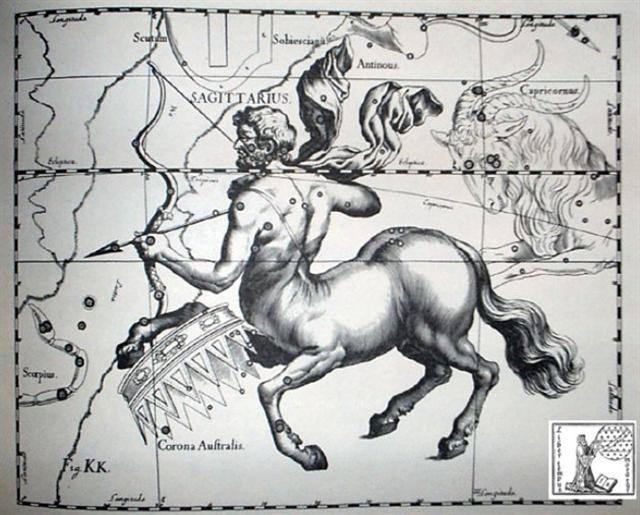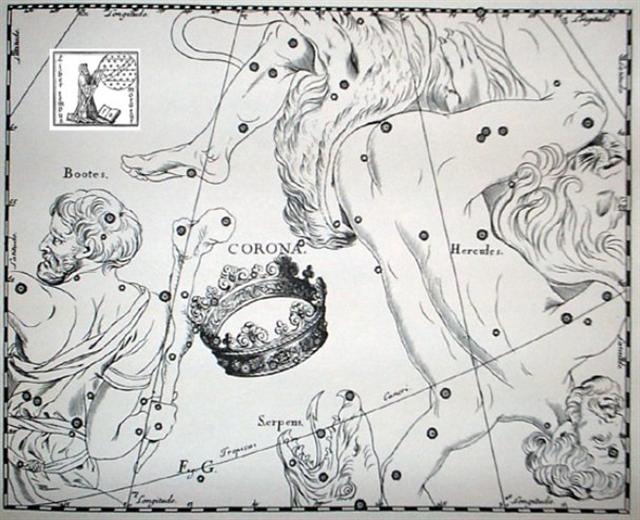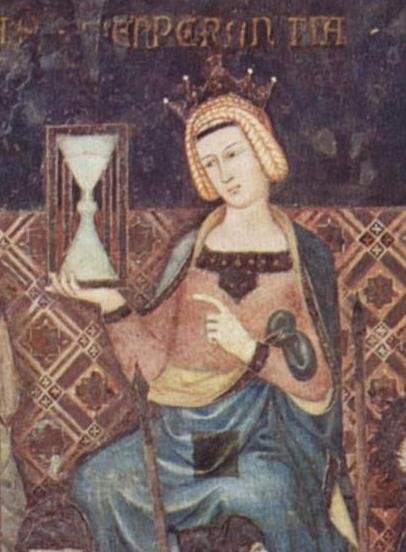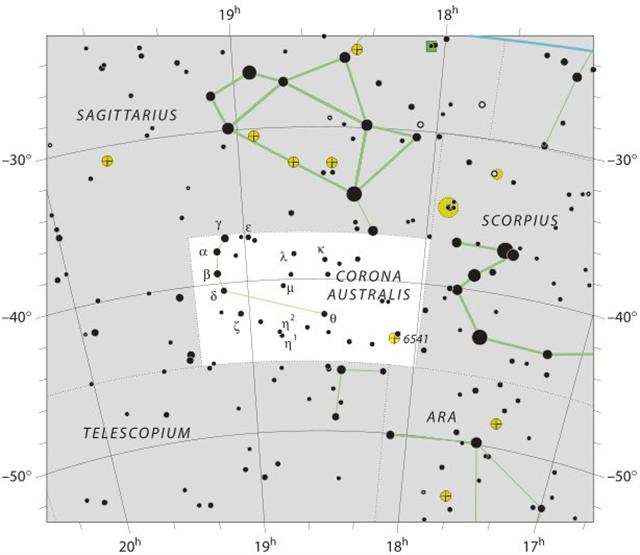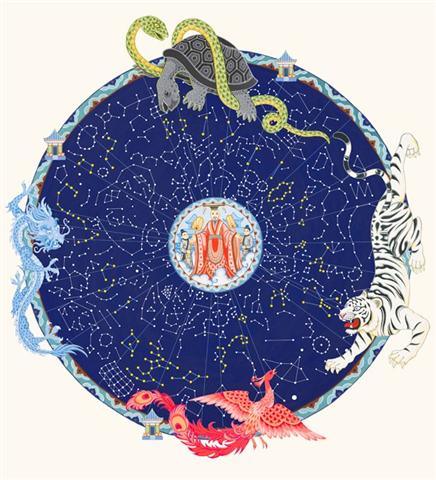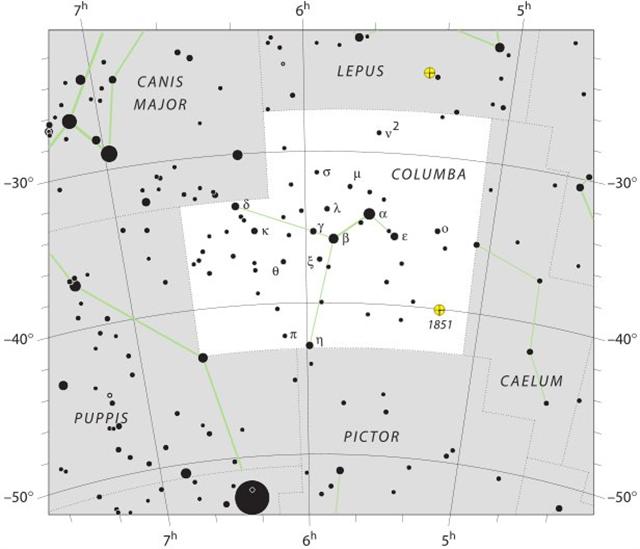Evidently there was a guardian Archer where the Milky Way river was bound to cross over and according to the Babylonians there was also a Cargo Boat waíting at this place:
At the opposite side of the sky (year) there was another Archer (Bow) who also was making it impossible to proceed further. Hevelius seems to have explained how the Cargo Boat (Corona Australis) offered a place onboard for the Serpent (and for the right front leg of the Man Horse):
Corona Australis was the opposite of Corona Borealis (the resting place for the Oak, Jupiter): ... Duir as the god of the oak month looks both ways because his post is at the turn of the year; which identifies him with the Oak-god Hercules who became the door-keeper of the Gods after his death. He is probably also to be identified with the British god Llyr of Lludd or Nudd, a god of the sea - i.e. a god of a sea-faring Bronze Age people - who was the 'father' of Creiddylad (Cordelia) an aspect of the White Goddess; for according to Geoffrey of Monmouth the grave of Llyr at Leicester was in a vault built in honour of Janus. Geoffrey writes: Cordelia obtaining the government of the Kingdom buried her father in a certain vault which she ordered to be made for him under the river Sore in Leicester (Leircester) and which had been built originally under the ground in honour of the god Janus. And here all the workmen of the city, upon the anniversary solemnity of that festival, used to begin their yearly labours. Since Llyr was a pre-Roman God this amounts to saying that he was two-headed, like Janus, and the patron of the New Year; but the Celtic year began in the summer, not in the winter. Geoffrey does not date the mourning festival but it is likely to have originally taken place at the end of June ... What I take for a reference to Llyr as Janus occurs in the closing paragraph of Merlin's prophecy to the heathen King Vortigern and his Druids, recorded by Geoffrey of Monmouth: After this Janus shall never have priests again. His door will be shut and remain concealed in Ariadne's crannies. In other words, the ancient Druidic religion based on the oak-cult will be swept away by Christianity and the door - the god Llyr - will languish forgotten in the Castle of Arianrhod, the Corona Borealis. This helps us to understand the relationship at Rome of Janus and the White Goddess Cardea who is ... the Goddess of Hinges who came to Rome from Alba Longa. She was the hinge on which the year swung - the ancient Latin, not the Etruscan year - and her importance as such is recorded in the Latin adjective cardinalis - as we say in English 'of cardinal importance - which was also applied to the four main winds; for winds were considered as under the sole direction of the Great Goddess until Classical times. As Cardea she ruled over the Celestial Hinge at the back of the North Wind around which, as Varro explains in his De Re Rustica, the mill-stone of the Universe revolves. This conception appears most plainly in the Norse Edda, where the giantesses Fenja and Menja, who turn the monstrous mill-stone Grotte in the cold polar night, stand for the White Goddess in her complementary moods of creation and destruction. Elsewhere in Norse mythology the Goddess is nine-fold: the nine giantesses who were joint-mothers of the hero Rig, alias Heimdall, the inventor of the Norse social system, similarly turned the cosmic mill. Janus was perhaps not originally double-headed: he may have borrowed this peculiarity from the Goddess herself who at the Carmentalia, the Carmenta Festival in early January, was addressed by her celebrants as 'Postvorta' and 'Antevorta' - 'she who looks both back and forward'. However, a Janus with long hair and wings appear on an early stater of Mellos, a Cretan colony at Cilicia. He is identified with the solar hero Talus, and a bull's head appears on the same coin. In similar coins of the late fifth century B.C. he holds an eight-rayed disc in his hand and has a spiral of immortality sprouting from his double head. Here at last I can complete my argument about Arianrhod's Castle and the 'whirling round without motion between three elements'. The sacred oak-king was killed at midsummer and translated to the Corona Borealis, presided over by the White Goddess, which was then just dipping over the Northern horizon. But from the song ascribed by Apollonius Rhodius to Orpheus, we know that the Queen of the Circling Universe, Eurynome, alias Cardea, was identical with Rhea of Crete; thus Rhea lived at the axle of the mill, whirling around without motion, as well as on the Galaxy. This suggests that in a later mythological tradition the sacred king went to serve her at the Mill, not in the Castle, for Samson after his blinding and enervation turned a mill in Delilah's prison-house. Another name for the Goddess of the Mill was Artemis Calliste, or Callisto ('Most Beautiful'), to whom the she-bear was sacred in Arcadia; and in Athens at the festival of Artemis Brauronia, a girl of ten years old and a girl of five, dressed in saffron-yellow robes in honour of the moon, played the part of sacred bears. The Great She-bear and Little She-bear are still the names of the two constellations that turn the mill around. In Greek the Great Bear Callisto was also called Helice, which means both 'that which turns' and 'willow-branch' - a reminder that the willow was sacred to the same Goddess ...
We can see the head of the Serpent reaching out from below for Corona Borealis, whereas his long tail (the undulating bow of Sagittarius) is just above the upside down Corona Australis. What does it mean? Perhaps it was a way to say that the Serpent (water), the shadow tanist of Jupiter (fire), would reach his final at heliacal Nash in December 19 (*273). ... The divine names Bran, Saturn, Cronos ... are applied to the ghost of Hercules that floats off in the alder-wood boat after his midsummer sacrifice. His tanist, or other self, appearing in Greek legend as Poeas who lighted Hercules' pyre and inherited his arrows, succeeds him for the second half of the year; having acquired royal virtue by marriage with the queen, the representative of the White Goddess, and by eating some royal part of the dead man's body - heart, shoulder or thigh-flesh. He is in turn succeeded by the New Year Hercules, a reincarnation of the murdered man, who beheads him and, apparently, eats his head. This alternate eucharistic sacrifice made royalty continous, each king in turn the Sun-god beloved of the reigning Moon-goddess. But when these cannibalistic rites were abandoned and the system was gradually modified until a single king reigned for a term of years, Saturn-Cronos-Bran became a mere Old Year ghost, permanently overthrown by Juppiter-Zeus-Belin though yearly conjured up for placation at the Saturnalia or Yule feast ...
"Al Sufi is our authority for the Arabs' Al Kubhah, literally the Tortoise, but secondarily the Woman's Tent, or traveling apartment from its form;
and it was Al Hibā', the Tent, and Kazwini's Al Udhā al Na'ām, the Ostrich's Nest, for the same reason; the birds themselves being close by in what now are the Archer and the Eagle. Al Fakkah, the Dish, was borrowed from the Northern Crown, but among the later Arabians it was Al Iklīl al Janūbiyyah, their equivalent of our title [the Southern Crown]; Chilmead giving this as Alachil Algenubi; Riccioli, Elkleil Elgenubi; and Caesius, Aladil Algenubi. The Chinese knew it by the figure current to early Arabs - Peē, the Tortoise." (Allen)
When the Winnowing (Harvest) Basket - at the arrow point of Sagittarius - was at the Full Moon it meant those 6 days allowed to live for Menkaure (Mycerinus) were finished: ... An oracle reached him from the town of Buto, which said 'six years only shalt thou live upon this earth, and in the seventh thou shalt end thy days' ...
Possibly, therefore, viri turned into a horizontal orientation in Ga1-26 was intended to illustrate a journey in a boat (a double-canoe). ... The divine names Bran, Saturn, Cronos ... are applied to the ghost of Hercules that floats off in the alder-wood boat after his midsummer sacrifice ... Only his head was still visible, was still preserved, and it was only his 'heart, shoulder or thigh-flesh', which had been eaten (kai).
... In China they [the stars in the Columba constellation] were Sun; the Child; λ being Tze, a Son; and the nearby small stars, She, the secretions ...
... Gronw Pebyr, who figures as the lord of Penllyn - 'Lord of the Lake' - which was also the title of Tegid Voel, Cerridwen's husband, is really Llew's twin and tanist ... Gronw reigns during the second half of the year, after Llew's sacrificial murder; and the weary stag whom he kills and flays outside Llew's castle stands for Llew himself (a 'stag of seven fights'). This constant shift in symbolic values makes the allegory difficult for the prose-minded reader to follow, but to the poet who remembers the fate of the pastoral Hercules the sense is clear: after despatching Llew with the dart hurled at him from Bryn Kyvergyr, Gronw flays him, cuts him to pieces and distributes the pieces among his merry-men. The clue is given in the phrase 'baiting his dogs'. Math had similarly made a stag of his rival Gilvaethwy, earlier in the story. It seems likely that Llew's mediaeval successor, Red Robin Hood, was also once worshipped as a stag. His presence at the Abbot's Bromley Horn Dance would be difficult to account for otherwise, and stag's horn moss is sometimes called Robin Hood's Hatband [Mad Hatter had put his label 'In this Style 10/6' in his hatband]. In May, the stag puts on his red summer coat. 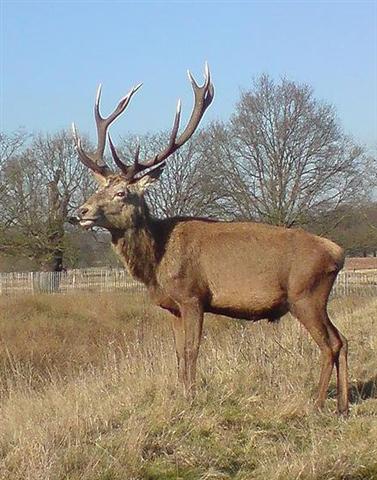 Llew visits the Castle of Arianrhod in a coracle of weed and sedge. The coracle is the same old harvest basket in which nearly every antique Sun-god makes his New Year voyage; and the virgin princess, his mother, is always waiting to greet him on the bank.
|
|||||||||||||||||||||||||||||||||||||||||||||||||||||||||||||||||||||||||||||||||||||||||||||||

